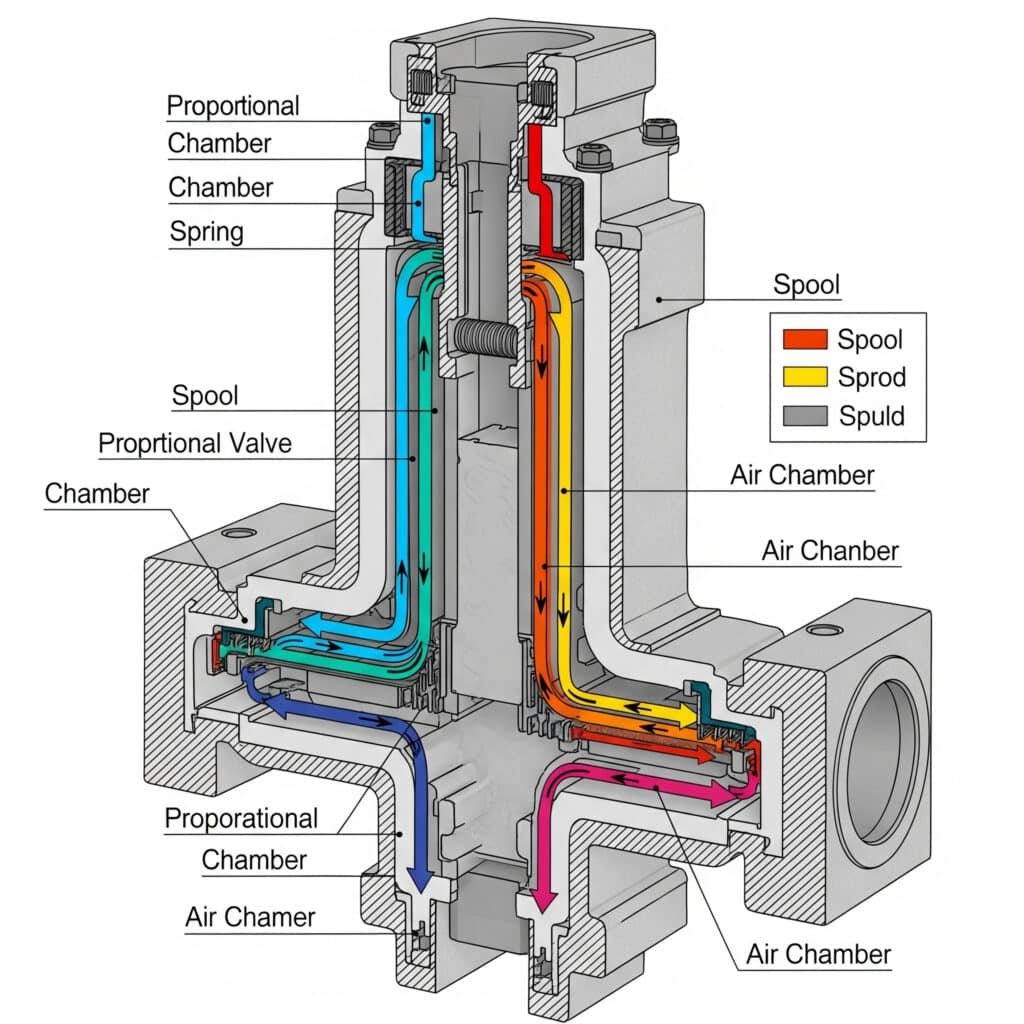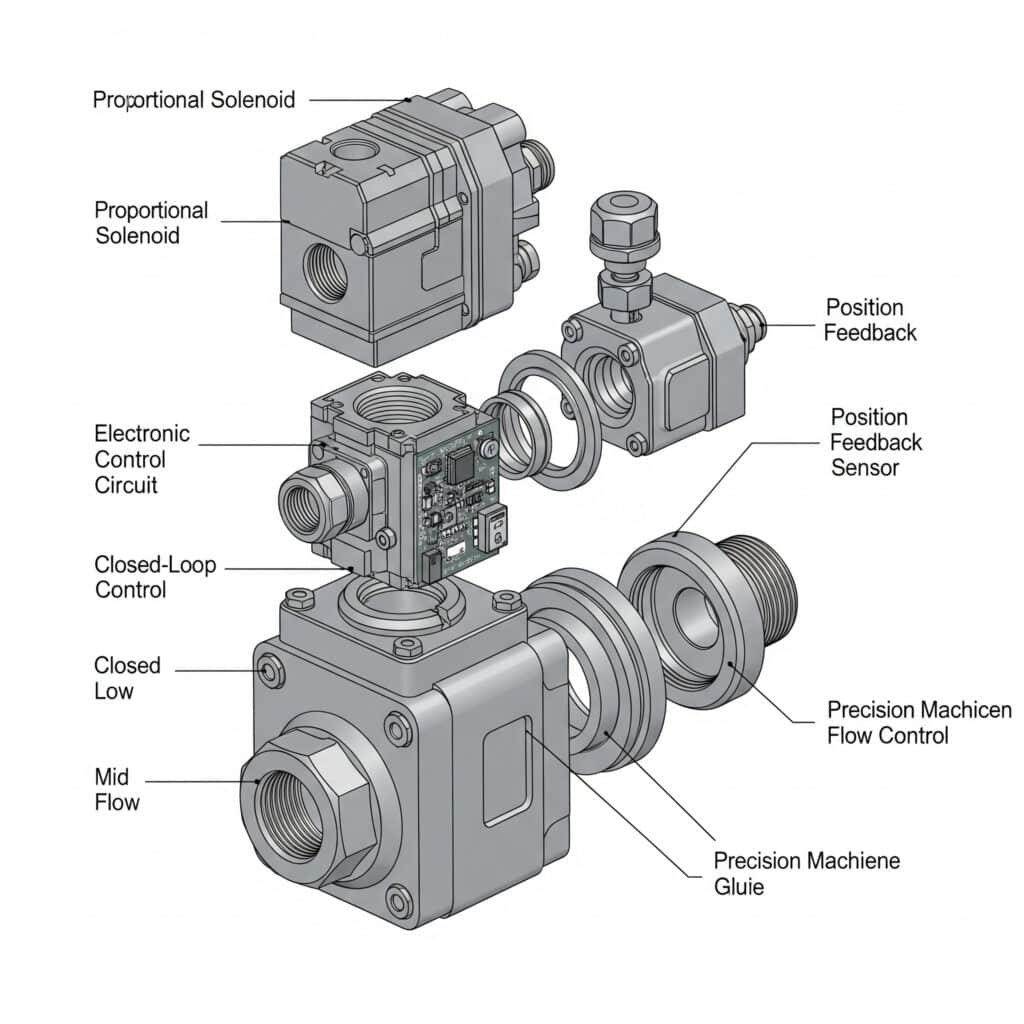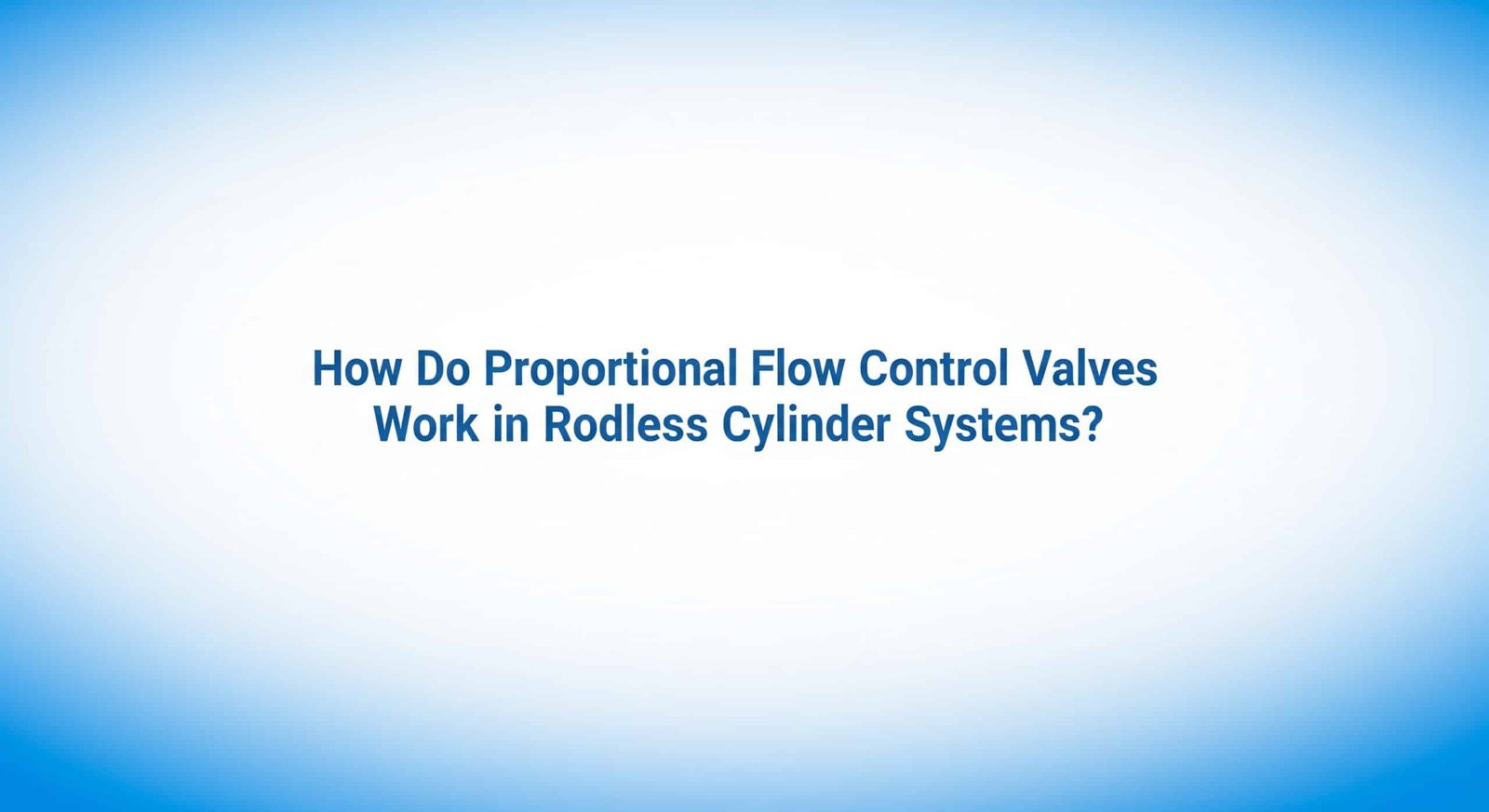Engineers struggle with jerky motion and poor speed control in their rodless pneumatic cylinder applications. Traditional on/off valves create abrupt starts and stops that damage equipment and reduce precision.
Proportional flow control valves work by continuously adjusting airflow rates based on electrical input signals, providing smooth speed control and precise positioning for rodless cylinder applications.
Last month, I helped Marcus, a maintenance engineer from Germany, whose packaging line suffered constant breakdowns because his rodless cylinders moved too aggressively with standard solenoid valves.
Table of Contents
- What Are Proportional Flow Control Valves?
- How Do These Valves Control Airflow in Rodless Systems?
- What Components Make Proportional Valves Work?
- Why Choose Proportional Control for Rodless Cylinders?
What Are Proportional Flow Control Valves?
Proportional flow control valves represent a major advancement over simple on/off pneumatic controls. These sophisticated devices bridge the gap between basic solenoid valves and expensive servo systems.
Proportional flow control valves are electronic pneumatic devices that vary airflow continuously from 0% to 100% based on analog input signals like 4-20mA1 or 0-10V.

Basic Operating Principle
Proportional valves receive electrical signals from your PLC2 or control system. The valve converts these signals into precise mechanical movements. This creates variable flow restrictions that control air speed.
Signal Types and Ranges
| Signal Type | Range | Common Use | Accuracy |
|---|---|---|---|
| Current | 4-20mA | Industrial standard | ±1% |
| Voltage | 0-10V | Simple applications | ±2% |
| Voltage | 0-5V | Legacy systems | ±2% |
| Digital | PWM/Fieldbus | Advanced control | ±0.5% |
Valve Response Characteristics
Most proportional valves offer linear response curves. A 50% input signal produces 50% maximum flow. Some valves provide custom curves for specific applications.
Response times typically range from 10-100 milliseconds. This speed allows real-time adjustments during cylinder operation.
Applications in Rodless Systems
I use proportional flow control valves for several rodless cylinder applications:
- Speed control during long strokes
- Soft start/stop operations
- Multi-speed positioning sequences
- Load-dependent speed adjustment
- Energy-efficient operation
How Do These Valves Control Airflow in Rodless Systems?
Airflow control in rodless cylinders requires precise management of both supply and exhaust air. Proportional valves achieve this through variable orifice control and electronic feedback systems.
Proportional valves control rodless cylinder speed by modulating supply air pressure and exhaust flow rates, creating smooth acceleration and deceleration profiles.
Supply Air Control Methods
Meter-In Control
Supply air throttling controls cylinder extension speed. The valve restricts incoming airflow based on your speed command signal.
Benefits:
- Simple installation
- Cost-effective solution
- Good for consistent loads
- Easy troubleshooting
Meter-Out Control
Exhaust air throttling provides better speed stability. The valve controls air leaving the cylinder during retraction.
Benefits:
- More stable speeds
- Better load handling
- Smoother operation
- Reduced air consumption
Pressure Regulation Techniques
| Method | Control Point | Speed Stability | Energy Efficiency | Cost |
|---|---|---|---|---|
| Supply throttling | Inlet | Good | Moderate | Low |
| Exhaust throttling | Outlet | Excellent | Good | Low |
| Pressure regulation | Supply pressure | Excellent | Excellent | High |
| Bi-directional | Both directions | Superior | Superior | High |
Electronic Control Integration
Modern proportional valves integrate directly with PLC systems. Your control program sends analog signals that correspond to desired speeds.
Common integration methods:
- Analog output modules (4-20mA)
- Voltage output cards (0-10V)
- Fieldbus3 communication (DeviceNet, Profibus)
- Ethernet-based protocols (EtherNet/IP)
Flow Calculation and Sizing
Proper valve sizing ensures adequate flow capacity for your rodless cylinder application. I calculate required flow using cylinder bore, stroke length, and desired cycle time.
Flow Formula: Q = (A × L × 60) / (t × 1000)
- Q = Flow rate (L/min)
- A = Cylinder area (cm²)
- L = Stroke length (cm)
- t = Time (seconds)
What Components Make Proportional Valves Work?
Proportional flow control valves contain sophisticated electronic and mechanical components that work together to provide precise airflow control.
Key components include proportional solenoids, electronic control circuits, position feedback sensors, and precision-machined flow control elements that enable accurate flow modulation.

Electronic Control Systems
Microprocessor Control
Modern valves use embedded microprocessors for signal processing. These chips handle input conditioning, linearization, and output control.
Key functions:
- Signal amplification and filtering
- Non-linearity compensation
- Temperature drift correction
- Diagnostic monitoring
Power Electronics
High-current driver circuits convert low-power control signals into actuator drive currents. These circuits provide precise current control for consistent valve positioning.
Mechanical Actuator Systems
Proportional Solenoids
These actuators convert electrical current into mechanical force. Unlike standard solenoids that are either on or off, proportional solenoids provide variable force output.
Specifications:
- Force range: 10-200N typical
- Response time: 10-50ms
- Resolution: 0.1% of full scale
- Hysteresis4: <2% typical
Servo Motor Actuators
High-precision applications use servo motors with gear reduction. These provide superior accuracy but slower response times.
Flow Control Elements
Variable Orifice Designs
| Design Type | Control Method | Flow Range | Precision | Applications |
|---|---|---|---|---|
| Needle valve | Linear positioning | 0-100% | High | General purpose |
| Ball segment | Rotary motion | 10-100% | Medium | High flow |
| Butterfly disc | Rotary motion | 5-95% | Medium | Large bore |
| Spool valve | Linear sliding | 0-100% | High | Servo applications |
Position Feedback Systems
Closed-loop valves use position sensors to verify actual valve opening. Common sensor types include:
- LVDT (Linear Variable Differential Transformer)5
- Hall effect sensors
- Potentiometers
- Optical encoders
Housing and Connection Features
Valve bodies are typically aluminum or brass construction. Connection options include:
- Push-in pneumatic fittings
- NPT threaded ports
- Manifold mounting interfaces
- DIN rail mounting brackets
Environmental protection ratings range from IP54 to IP67 depending on application requirements.
Why Choose Proportional Control for Rodless Cylinders?
Proportional flow control offers significant advantages over traditional on/off valves in rodless cylinder applications, including improved precision, reduced wear, and enhanced system performance.
Proportional control provides smooth motion profiles, precise speed control, energy savings, and extended equipment life compared to standard pneumatic valves.
Performance Benefits
Motion Quality Improvements
Proportional control eliminates the jerky motion common with on/off valves. Your rodless cylinders achieve smooth acceleration and deceleration profiles.
I recently worked with Sarah, a production manager from the UK, whose assembly line improved product quality by 40% after switching to proportional control on their rodless cylinder positioning systems.
Speed Control Precision
Variable speed control allows optimization for different load conditions. Heavy loads can move slower while light loads move faster, optimizing cycle times.
Economic Advantages
Energy Savings
Proportional valves reduce compressed air consumption by eliminating pressure spikes and flow surges. Typical savings range from 15-30% compared to on/off systems.
Reduced Maintenance Costs
Smooth operation reduces wear on cylinder seals, guides, and mechanical components. This extends service intervals and reduces replacement part costs.
Application-Specific Benefits
Manufacturing Applications
| Application | Benefit | Improvement |
|---|---|---|
| Assembly lines | Consistent positioning | ±0.1mm repeatability |
| Packaging | Gentle product handling | 50% less damage |
| Material handling | Variable speeds | 25% faster cycles |
| Testing equipment | Precise control | Better test accuracy |
System Integration Advantages
Proportional valves integrate easily with modern control systems. They accept standard industrial signals and provide diagnostic feedback for predictive maintenance.
Selection Considerations
When choosing proportional flow control for your rodless cylinder application, consider:
- Flow requirements: Calculate maximum flow needs
- Response time: Match valve speed to application needs
- Accuracy requirements: Determine acceptable tolerance
- Environmental conditions: Temperature, humidity, contamination
- Control interface: Signal types and communication protocols
Cost-Benefit Analysis
While proportional valves cost more initially than simple solenoid valves, the benefits typically justify the investment:
- Reduced air consumption saves operating costs
- Less maintenance reduces downtime
- Improved product quality increases revenue
- Extended equipment life delays replacement costs
Conclusion
Proportional flow control valves work by converting electrical signals into precise airflow control, providing smooth operation and enhanced performance for rodless cylinder systems.
FAQs About Proportional Flow control Valves
How do proportional flow control valves work?
Proportional flow control valves work by converting electrical input signals (4-20mA or 0-10V) into variable mechanical positioning of internal flow control elements, creating continuously adjustable airflow rates for precise speed control in pneumatic systems.
What’s the difference between proportional and standard solenoid valves?
Standard solenoid valves are either fully open or closed, while proportional valves provide infinite positioning between 0-100% open. This allows smooth speed control instead of abrupt on/off operation in rodless cylinder applications.
Can proportional valves work with existing PLC systems?
Yes, proportional flow control valves accept standard industrial analog signals like 4-20mA and 0-10V that most PLCs provide. Many valves also support digital fieldbus communication protocols for advanced integration.
How much air do proportional valves save compared to on/off valves?
Proportional flow control valves typically reduce compressed air consumption by 15-30% compared to standard on/off systems by eliminating pressure spikes and optimizing flow rates for actual application requirements.
What maintenance do proportional flow control valves require?
Proportional valves require periodic calibration checks, electrical connection inspection, and air filter replacement. Most valves provide diagnostic outputs that indicate when maintenance is needed, enabling predictive maintenance scheduling.
-
Understand the principles of the 4-20mA analog current loop, a robust standard for industrial instrumentation. ↩
-
Learn about the fundamentals of Programmable Logic Controllers (PLCs) and their role in industrial automation. ↩
-
Explore the concept of Fieldbus technology and how it enables real-time, distributed control in industrial networks. ↩
-
Review the definition of hysteresis and its significance as a source of error in measurement and control systems. ↩
-
See a technical guide on the working principle of Linear Variable Differential Transformers (LVDTs) for precision displacement sensing. ↩




